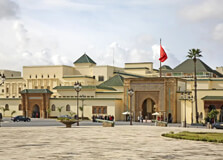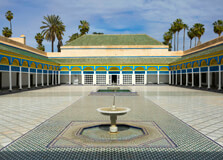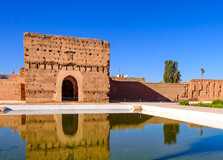
- Home
- Travel Packages
- Top Destination
-
Travel Attraction
By Category
Top Attraction

- Travel Agents
- Car Rentals
- Hotels

The Royal Rabat Palace, also known as Dar al-Makhzen, is the official residence of the King of Morocco. It is one of the most significant landmarks in Rabat, serving as the center of royal and governmental activities. While the palace itself is not open to the public, visitors can admire its grand exterior and witness the impressive ceremonial guards. How to Reach Royal Rabat Palace, Rabat Rabat is well-connected, making it easy to reach the Royal Palace: By Air: Rabat-Salé Airport is the nearest airport, about 10 km from the city center. By Train: The Rabat Ville train station is close to the palace and connects to major cities in Morocco. By Bus: Local buses and taxis offer convenient access to the palace area. By Car: Visitors can drive or hire a taxi to reach the palace. Weather in Rabat Rabat enjoys a Mediterranean climate, with mild, rainy winters and warm, dry summers. The best time to visit is in spring (March-May) and autumn (September-November) when the weather is pleasant. Timings of Royal Rabat Palace The Royal Palace is not open for public visits, but the exterior and surroundings can be viewed: Best viewing hours: 9 AM - 6 PM Guard changing ceremonies occur at specific intervals. Why is the Royal Rabat Palace Famous? The Royal Rabat Palace is famous for: Being the official residence of the Moroccan King. Its stunning architectural beauty and expansive grounds. Serving as the political and administrative center of Morocco. The grand ceremonial guards at its gates. Entry and Visit Details Access to the interior of the Royal Palace is restricted. However, visitors can view the impressive gates, take photographs from outside, and watch the ceremonial guards. History and Architecture The Royal Palace in Rabat was built in the 18th century and has been the residence of Morocco’s kings ever since. Its architecture reflects traditional Moroccan designs with intricate tilework, elegant courtyards, and grand arched gateways. The palace is surrounded by lush gardens and administrative buildings. Things to Do at Royal Rabat Palace Admire the stunning gates and royal guards. Take photographs of the grand architecture. Explore the surrounding areas, including lush gardens and government buildings. Visit nearby attractions such as the Hassan Tower and the Mausoleum of Mohammed V. Facts and Tips about Royal Rabat Palace Photography of the palace exterior is allowed, but security personnel may restrict some areas. Visitors should dress modestly as a sign of respect. The palace is one of several royal residences in Morocco, with others located in Fez and Marrakech. The best time to visit is in the morning or late afternoon for better lighting and fewer crowds.
Explore More
Bahia Palace is one of the most magnificent and well-preserved historical sites in Marrakech, Morocco. Built in the late 19th century, this grand palace is an architectural masterpiece that reflects the opulence of Moroccan and Islamic design. It is a must-visit destination for tourists interested in history, culture, and stunning craftsmanship. How to Reach Bahia Palace, Marrakech Bahia Palace is conveniently located in the heart of Marrakech’s Medina, making it easily accessible by various means of transportation: By Air: The nearest airport is Marrakech Menara Airport (RAK), about 6 km from the palace. By Taxi: Taxis are a common and affordable way to reach Bahia Palace from different parts of the city. By Foot: If you're staying near the Medina, you can walk to the palace and explore the surrounding historical attractions. By Bus: Local buses run through the Medina, and there are stops near the palace. Weather in Marrakech Marrakech has a semi-arid climate with hot summers and mild winters. The best time to visit Bahia Palace is in spring (March-May) and autumn (September-November) when temperatures are pleasant for sightseeing. Timings of Bahia Palace Bahia Palace is open to visitors daily: Monday to Sunday: 9:00 AM - 5:00 PM It is recommended to visit early in the morning to avoid crowds. Why is Bahia Palace Famous? Bahia Palace is famous for: Its breathtaking Moroccan architecture with intricate tilework and carved wooden ceilings. The large courtyard surrounded by beautiful gardens. Historical significance as a former residence of Moroccan rulers. Being one of the most photographed sites in Marrakech. Entry and Visit Details Entry Fee: Adults: 70 MAD Children under 12: Free Guided tours are available for those who want a deeper understanding of the palace’s history and significance. History and Architecture Bahia Palace was built in the late 19th century by Grand Vizier Si Moussa for his personal use. The name "Bahia" means "brilliance," and the palace was intended to be the most beautiful of its time. The design features traditional Moroccan elements, including: Stunning mosaics and zellige tilework. Ornate wooden ceilings and stucco carvings. Serene gardens with fountains and orange trees. Expansive courtyards and luxurious rooms. Things to Do at Bahia Palace Explore the grand courtyard and take in its stunning tilework. Wander through the lush gardens filled with aromatic plants. Admire the intricate ceilings and detailed carvings in each room. Take photographs of the palace’s architectural beauty. Join a guided tour to learn more about its historical significance. Facts and Tips about Bahia Palace Bahia Palace is a UNESCO-listed heritage site and a prime example of Moroccan architecture. Arriving early in the morning helps avoid large crowds. There are no furnishings inside, as the palace was looted after the fall of its owner. It is a great place for photography, so bring a good camera. The palace is close to other major attractions like Jemaa el-Fnaa Square and the Saadian Tombs.
Explore More
Jardin Majorelle is one of the most enchanting and visited attractions in Marrakech, Morocco. Originally designed by the French painter Jacques Majorelle in the early 20th century, this botanical garden is famous for its vibrant blue color, lush greenery, and serene atmosphere. It was later restored by fashion designer Yves Saint Laurent, making it a cultural landmark. How to Reach Jardin Majorelle, Marrakech Jardin Majorelle is located in the heart of Marrakech and is easily accessible by different means of transport: By Air: The nearest airport is Marrakech Menara Airport (RAK), around 7 km from the garden. By Taxi: Taxis are the most convenient way to reach the garden from different parts of the city. By Foot: If you are staying in the Medina, you can enjoy a 20-minute walk to the garden. By Bus: Public buses and hop-on-hop-off tourist buses stop near the garden. Weather in Marrakech Marrakech has a semi-arid climate with hot summers and mild winters. The best time to visit Jardin Majorelle is in the spring (March-May) or autumn (September-November) when temperatures are pleasant for outdoor exploration. Timings of Jardin Majorelle Jardin Majorelle is open daily, but it is advisable to check for any special holiday closures: Monday to Sunday: 8:00 AM - 6:00 PM Last admission: 5:30 PM Visiting early in the morning or late in the afternoon helps avoid large crowds. Why is Jardin Majorelle Famous? Jardin Majorelle is famous for: Its unique cobalt blue buildings, known as "Majorelle Blue." A diverse collection of exotic plants from different continents. Being the former residence of the renowned fashion designer Yves Saint Laurent. The on-site Berber Museum showcasing traditional Moroccan culture. Entry and Visit Details Entry Fees: Garden: 120 MAD for adults, 60 MAD for Moroccan residents. Yves Saint Laurent Museum: 100 MAD. Berber Museum: 30 MAD. Tickets can be purchased online or at the entrance. Due to high demand, online booking is recommended. History and Architecture Jardin Majorelle was created by Jacques Majorelle in the 1920s and 1930s. Inspired by Art Deco and Moorish styles, he developed a vibrant, exotic garden filled with rare plant species. The famous "Majorelle Blue" was his signature color, giving the garden its iconic look. In the 1980s, Yves Saint Laurent and Pierre Bergé acquired and restored the garden, preserving its beauty and legacy. Today, it is a symbol of cultural fusion, art, and design. Things to Do at Jardin Majorelle Wander through the lush gardens and admire exotic plants. Visit the Berber Museum to learn about Morocco’s indigenous culture. Explore the Yves Saint Laurent Museum dedicated to the legendary designer. Relax by the fountains and enjoy the peaceful atmosphere. Take stunning photographs of the vibrant blue buildings and colorful gardens. Facts and Tips about Jardin Majorelle The garden receives over 700,000 visitors annually, so early visits are recommended. Yves Saint Laurent’s ashes were scattered in the garden after his passing in 2008. The garden is wheelchair accessible. There is a small café inside offering refreshments. Photography is allowed, but tripods are not permitted.
Explore More
El Badi Palace is one of the most famous historical landmarks in Marrakech, Morocco. Built in the late 16th century by Sultan Ahmad al-Mansur of the Saadian dynasty, it was once a grand palace known for its luxurious design and exquisite materials. Today, it stands as a magnificent ruin, attracting visitors from around the world to explore its vast courtyards, underground passages, and impressive remnants of Moroccan architecture. How to Reach El Badi Palace, Marrakech El Badi Palace is located in the southern part of Marrakech’s Medina, close to other popular attractions like the Saadian Tombs and Bahia Palace. By Air: The nearest airport is Marrakech Menara Airport (RAK), about 6 km from the city center. By Taxi: Taxis are readily available throughout Marrakech and can take you to the palace in about 15 minutes from most parts of the city. By Foot: If you are staying in the Medina, the palace is within walking distance from Jemaa el-Fnaa. By Bus: Local buses and tourist buses stop near the Medina, making it easy to reach the site. Weather in Marrakech Marrakech has a hot semi-arid climate with high temperatures in summer and mild winters. The best time to visit is between March and May or from September to November when the weather is pleasant. Timings of El Badi Palace The palace is open to visitors every day with the following schedule: Monday to Sunday: 9:00 AM - 5:00 PM Last entry: 4:30 PM It is advisable to visit early in the morning or late afternoon to avoid crowds and the midday heat. Why is El Badi Palace Famous? El Badi Palace is famous for: Its historical significance as a royal palace built by Sultan Ahmad al-Mansur. The impressive ruins that offer a glimpse into Morocco’s rich history. The beautiful courtyards, underground chambers, and stunning views from the walls. Its role as a venue for cultural events and the Marrakech Popular Arts Festival. Entry and Visit Details Entry Fees: Adults: 70 MAD Children under 12: Free Tickets can be purchased at the entrance. History and Architecture El Badi Palace was constructed in the late 16th century by Sultan Ahmad al-Mansur to celebrate his victory over the Portuguese in the Battle of the Three Kings. The palace was once adorned with gold, marble, and intricate zellij tilework. The architecture features a grand central courtyard with a massive pool, surrounded by remnants of gardens, fountains, and pavilions. Although the palace was later dismantled by Sultan Moulay Ismail in the 17th century, the ruins still reflect the grandeur of its past. Things to Do at El Badi Palace Explore the vast courtyard and imagine its former splendor. Visit the underground passages and hidden chambers. Climb to the terrace for a panoramic view of Marrakech. Observe the resident storks that have built nests on the palace walls. Learn about the palace’s history through informational displays. Facts and Tips about El Badi Palace El Badi means “The Incomparable” in Arabic. The palace took 25 years to complete. Many of its materials, including marble, were taken from European countries like Italy. The site is a popular location for film and photography. Wear comfortable shoes as there is a lot of walking involved.
Explore More
The Atlas Mountains are a majestic mountain range that stretches across Morocco, Algeria, and Tunisia, with the Moroccan section being the most well-known and accessible. Near the city of Ouarzazate, the mountains are especially striking, forming a dramatic backdrop to the desert landscape. The region includes the High Atlas, Middle Atlas, and Anti-Atlas ranges, each offering its own unique beauty. In the Ouarzazate region, the High Atlas Mountains dominate the landscape. These peaks are known for their rugged terrain, picturesque valleys, Berber villages, and winding mountain passes. Visitors come here to experience the natural beauty, explore traditional lifestyles, hike scenic trails, and enjoy panoramic views that change with the seasons. How to Reach The Atlas Mountains, Ouarzazate Reaching the Atlas Mountains from Ouarzazate is relatively simple. Many routes lead into the mountains, depending on which part of the range you want to explore. The High Atlas range lies to the north of Ouarzazate and can be accessed via the N9 road that leads to Marrakesh through the famous Tizi n'Tichka Pass. You can rent a car in Ouarzazate for a self-drive adventure or book a guided tour that includes transportation, stops at villages, and hiking routes. Local taxis or 4x4 vehicles are also available for hire, especially for those visiting smaller towns like Telouet, Ait Benhaddou, or Toundoute nestled in the mountains. Weather in The Atlas Mountains The Atlas Mountains have a diverse climate depending on elevation. Lower slopes near Ouarzazate experience a semi-arid climate, while higher elevations have cooler temperatures and occasional snowfall in winter. Summer (June to August) brings mild to warm days with temperatures ranging from 20°C to 30°C (68°F to 86°F). Winter (December to February) can be quite cold in the higher elevations, with snow common on the peaks and chilly temperatures in the valleys. Spring and autumn are the most pleasant times to visit, offering clear skies, blooming wildflowers, and ideal conditions for hiking and sightseeing. Timings and Entry Details The Atlas Mountains are not a single enclosed site but a vast region, so there are no specific entry points or hours. You can visit freely at any time. However, guided treks, mountain lodges, and national parks within the mountains may have their own hours of operation and booking requirements. For areas like the Tizi n'Tichka Pass or Telouet Kasbah, visitors can stop any time during daylight hours. Entry to private kasbahs or cultural centers may cost between 10 to 50 Moroccan dirhams. Trekking expeditions or excursions often start in the early morning and require advanced reservations. Why is The Atlas Mountains, Ouarzazate Famous? The Atlas Mountains near Ouarzazate are famous for their stunning natural scenery, ancient Berber culture, traditional villages, and dramatic landscapes. The High Atlas range in particular is known for deep valleys, gorges, and scenic passes like Tizi n'Tichka, which offers panoramic views over the mountains and desert. These mountains are also a gateway between Morocco’s Sahara Desert and the rest of the country. The region is rich in history and has been a vital trade and migration route for centuries. It is also popular among trekkers, nature lovers, and photographers due to its unspoiled beauty and cultural significance. History and Architecture The Atlas Mountains have been home to Berber (Amazigh) communities for thousands of years. These indigenous people developed unique forms of architecture adapted to mountain life. Villages are often built from stone and clay, perched on hillsides or nestled in valleys for protection and warmth. One of the most famous architectural highlights in the region is Kasbah Telouet, once the residence of the powerful Glaoui family. The kasbah features beautiful zellige tile work, carved cedarwood ceilings, and mudbrick fortifications. Ancient irrigation systems, terraced farms, and communal granaries are also part of the cultural landscape. Things to Do in The Atlas Mountains near Ouarzazate There’s no shortage of activities in the Atlas Mountains. Here are some of the best things to do: Drive the Tizi n'Tichka Pass: Experience one of Morocco’s most scenic roads, connecting Ouarzazate with Marrakesh. Visit Kasbah Telouet: Explore a historic palace rich with cultural and political history. Hiking and Trekking: Discover beautiful trails that lead to mountain villages, waterfalls, and panoramic viewpoints. Explore Berber Villages: Visit traditional Amazigh homes and learn about their culture, food, and crafts. Photography: Capture the vibrant contrast between snow-capped peaks, red earth, and green valleys. Visit Local Markets: Weekly souks in mountain villages are a great way to experience local life and buy handmade goods. Stay in a Riad or Mountain Lodge: Enjoy Moroccan hospitality with traditional food, architecture, and views. Interesting Facts and Travel Tips Here are some facts and practical tips for your visit to the Atlas Mountains near Ouarzazate: The High Atlas Mountains contain Jbel Toubkal, North Africa’s highest peak, though it's further west from Ouarzazate. Berbers make up the majority of the population in the mountain regions and maintain ancient customs and dialects. Winter brings snow to the higher elevations, and you can even find skiing in areas like Oukaimeden (closer to Marrakesh). Wear layers, as temperatures can vary greatly between day and night, especially in spring and autumn. Bring good walking shoes if you plan to hike, as trails can be rocky or uneven. Always carry water and sun protection—UV exposure is higher at altitude. Hiring a local guide helps you navigate safely and supports local communities economically. Conclusion The Atlas Mountains near Ouarzazate offer one of Morocco’s most captivating landscapes—a place where nature, culture, and history blend seamlessly. Whether you're driving through the scenic Tizi n'Tichka Pass, visiting ancient kasbahs like Telouet, hiking through remote trails, or simply enjoying the cool mountain air, the experience is unforgettable. This region is perfect for those who love adventure, culture, and raw beauty. It’s a must-see for any traveler visiting Morocco.
Explore More